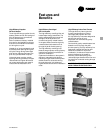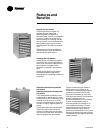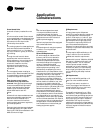
9UH-PRC002-EN
Application
Considerations
Indoor Units
Indoor gas unit heaters and duct
furnaces are used primarily in
commercial and industrial structures
such as manufacturing areas,
warehouses, garages, stores,
showrooms, lobbies and corridors.
Separated combustion units are used
primarily in industrial work areas with
wood or textile dust, non-explosive
contaminated environments, non-
chlorine process areas, automotive and
truck garages and greenhouses.
Unit Placement
Refer to the applicable Trane Installation,
Operation and Maintenance literature for
specific installation instructions.
Installations must conform with local
building codes or in the absence of local
codes with the National Fuel Gas Code
ANSI Z223.1.
When selecting a location for an indoor
unit heater, both the size and weight of
the unit, as well as the heating
requirements of the building, should be
considered. Installation of units in
airplane hangars or public garages
should be in accordance with NFPA No.
409 for aircraft hangars, and NFPA No.
88 for garages.
For proper distribution, air should be
directed towards areas of maximum
heat loss. When multiple units are used,
circulation of heated air around the
space perimeter is recommended.
Satisfactory results can also be obtained
where multiple units are located toward
the center of the area, with heated air
being discharged toward the outside
walls. Throw data for standard unit
heaters and unit heaters utilizing
optional discharge nozzles is shown in
the General Data section, pages 19 and
20.
Locations where extreme drafts can
affect burner operation should be
avoided. Strong drafts may cause pilot
outage. Units with intermittent pilot
ignition may be preferable in areas
where drafts are likely.
Minimum clearances required for
accessibility and safety are listed in Table
GD-1.
Throw Data
Throw data for units with standard
louvers and for units with optional
discharge nozzles are in the General Data
section, pages 19 and 20. Optional
nozzles are for use on propeller fan unit
heaters, centrifugal fan unit heaters and
duct furnaces. When greater throw
distance is desired, a 45° nozzle is
recommended. For high mounting
heights, a 90° nozzle may be used. When
wide diffusion is needed, a Y splitter
nozzle should be considered. A five-way
nozzle can be used for applications
requiring even air distribution over a
large floor area. (Five-way nozzles are
not available on propeller fan unit
heaters.)
Indoor Units — Venting
Gas fired indoor units require venting to
remove the products of combustion. To
help assure safe, trouble-free operation,
follow the guidelines listed below:
Natural Venting
1
Provide a vertical flue of at least four feet.
2
Use a flue the same size as the flue
opening on the unit.
3
Provide maximum vertical rise at the
units.
4
Keep horizontal runs to a minimum and
slope flue upward at least ¼-inch per
foot. Horizontal runs should not
exceed 75 percent of the vertical
height of the vent pipe, or chimney,
above the flue pipe connection.
5
Avoid short turns; 45° elbows are
recommended.
6
The vent pipe should be at least six
inches from combustible material and
should be properly insulated when
passing through combustible partitions.
7
Extend flue at least two feet above the
highest point of the roof.
8
Tape flue pipe joints with fireproof paper
or material.
9
Avoid installing units in areas under
negative pressure.
10
Avoid running vent pipe through
unheated spaces. When this cannot be
avoided, insulate the pipe to prevent
condensation of moisture on the inside
walls of the pipe.
11
Where two or more units vent into a
common flue, the cross-sectional area of
the common flue must be equal to the
larger vent connection plus 50 percent of
the area of each additional vent
connection. (Gravity vent units only.)
12
Do not damper the flue piping. Failure to
open such a damper prior to operating
the unit will result in the spillage of flue
gas into the occupied space, activating
the blocked vent (spill) switch.
Flue Vent Fans
Where chimneys of sufficient height are
impractical, or where the distance from
the heater to the chimney is so great that
sufficient draft cannot be created, a flue
vent fan can be used to vent the
products of combustion. The flue vent
fan is normally started and stopped by
the room thermostat. A centrifugal
switch in the flue vent fan operates the
electric gas valve.
Dimensional data for the flue vent fan is
shown in Table DW-14.


















